Your Definitive Guide To Modern & Professional Procurement Reports
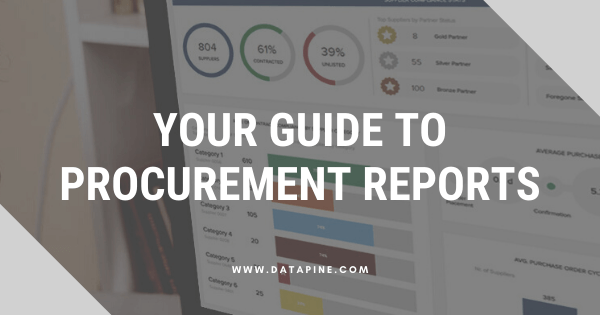
Table of Contents
1) What Are Procurement Reports?
2) Why Are Procurement Reports Important?
3) What Should Be In A Procurement Report?
4) Procurement Analytics Steps & Tips
5) Procurement Reporting Challenges
Innovation, branding, and business model aside, if your company is rife with inefficiencies and led by poor decision-making, your growth potential will become stunted. Whatever sector or industry you are in, procuring goods and services both efficiently and strategically will accelerate your success. Effective procurement analytics will save you time and money while making your organization more productive and sustainable.
If your procurement process costs you valuable time and incurs unnecessary costs, you may fall behind your competitors.
However, we live in a digital age where statistics, data, and deep-dive insights reign supreme, giving us the power to spot potential issues and inefficiencies within the business. Thanks to the right KPI software, it is much easier to identify trends and set goals to increase productivity, drive growth, and boost profits.
Here, we will uncover the power of company procurement reports, consider their importance in the digital age, and look at how to make them. We will also explain the benefits and challenges of dealing with these reports to provide you with innovative ideas for spotting inefficiencies.
Let’s get started.
What Are Procurement Reports?


A procurement report shows how a business’s procurement activities deliver value for money and contribute to realizing broader goals and objectives. They provide a panoramic snapshot of supplier performance and the purchasing process of different products and services.
By tracking the right procurement KPI, a company gains the power to enhance its strategy by preventing minor inefficiencies from becoming significant issues and providing a clear insight into the practices or supplier relationships that work, as well as those that don’t.
Throughout the years, these reports have been created and managed through traditional means of data management such as spreadsheets or static presentations but companies need to hurl these stone-age practices and start utilizing modern online reporting software that will transform your results and, ultimately, increase profits. Next, we will see their importance in more detail, alongside the most common challenges.
Why Are Procurement Reports Important?
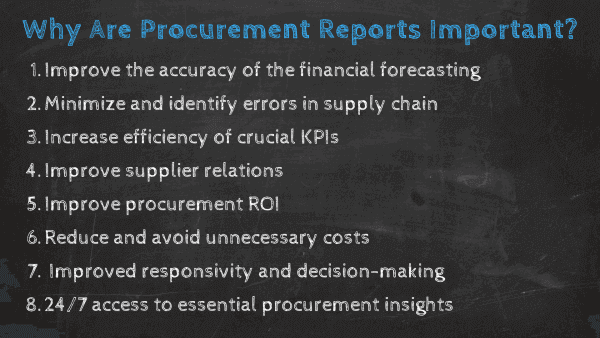

In an age when digital data offers a wealth of boosting insight, businesses cannot afford to shoot in the dark regarding their strategies.
An IDC study shows that over 80% of business leaders surveyed from sales, HR, procurement, and other departments agreed that issues arise because companies have different internal systems and applications that don’t ‘talk’ to one another. Forty-three percent of the staff surveyed said they often have to copy and paste or rekey in information, wasting time and hindering productivity.
Common sourcing reports that drill down to significant areas of the procurement process have the power to help you make the kind of improvement that can make or break your business in today’s cutthroat digital climate. Data reporting is the crystal ball that offers a glimpse into the past, present, and future of a company’s activities, helping it move forward in the best and most sustainable way possible.
There are a host of benefits to a well-made procurement reporting structure. Some of them include:
1. Improve the accuracy of the financial forecasting
You can easily increase financial efficiencies and save costs by identifying potential problem areas in your organization. If you track your costs regularly, your purchasing department monthly reports will be filled with crucial financial analytics insights that will help you streamline your supplier management processes, identify if you need to train your staff on how to reduce costs, and ensure continuous monitoring to ensure your finances are being well managed and efficient. Financial forecasting is vital to the ongoing health of your procurement activities. Using modern dashboards, you can deliver your projections with pinpoint accuracy. But not only, but the use of interactive financial charts will also make your exploration processes quicker and easier.
2. Minimize errors throughout the supply chain
By monitoring your dependency on providers over a set period and identifying which ones deliver the right product or service at precisely the right time, you can analyze your suppliers’ performance with ease while conducting comparisons throughout your business. With the help of a dashboard designer, you can simply drag and drop your values and create interactive visualizations that will point out errors immediately. That way, you can significantly reduce errors and increase your productivity levels.
3. Increase the efficiency of crucial KPIs
With so many areas to consider, deciding which KPIs to focus on while defining metric measurement periods can prove to be a challenge at the initial stages. Scaling the value of analytics across all areas of your procurement process might prove difficult in the beginning, but by ensuring that all key members of your team have access to your KPI reports and understand how to leverage the data to their advantage, the steps to take towards your strategy will swiftly become clear. For example, you might want to track crucial order cycle times and order fulfillment speeds to be able to handle urgent orders and take into account providers that can fulfill your requirements quickly and without additional complexities.
4. Understand which relationships are working
If you create regular purchasing reports, you can easily identify which suppliers are not only available during your urgent times but also classify them based on a number of other criteria, such as special discounts, reaction time, and other compliance parameters of your contract. That way, you can introduce categories for each provider and identify which ones keep a good relationship with your company on the one hand and, on the other, which need termination or replacement. We will see this in our examples below in the article.
5. Take accurate measurements
Another benefit is how they provide a wealth of opportunities to improve your ROI based on your various procurement actions, initiatives, and activities. Both the short-term and long-term goals of your business will be fulfilled by offering a panoramic snapshot of every critical aspect of your journey. By benchmarking your success accurately, you stand to increase your ROI while maintaining a standard of excellence that will drive you forward.
6. Reduce and avoid unnecessary costs
With procurement being such a critical component, providing the oil that greases the organizational cogs and keeps everything flowing, along with monitoring and analyzing all aspects of the process, is essential. From costs and delivery to compliance rates and order cycle time, there is a wealth of insights to explore.
As the company evolves and grows, scaling your common procurement efforts to reflect the new business demands might also prove challenging. However, by taking a collaborative approach and following some dashboard best practices to remain in line with your key business goals and objectives, you’ll be able to avoid fragmentation and continue to benefit from the insights that are the most valuable.
7. Improve responsivity and decision-making under pressure
Like in almost every business process imaginable, incidents can occur, and things can go wrong. By working with the right procurement analysis report, you can respond to potential challenges or changes ‘at the moment’ and create quick-fire solutions to save time and money.
A cohesive mix of accurate real-time and dynamic online data visualization means you can pinpoint the issue at a glance and make strategic decisions with complete confidence. As such, your supply chain can remain fluent at all times.
8. Gain 24/7 access to essential insights
Another stand-out benefit is the universal access to analytics that modern BI dashboards provide.
Modern sourcing reports are accessible across many devices, including desktops, tablets, and smartphones. Rather than relying on data when you’re in the office or at specific locations, modern procurement-based tools will empower you to access invaluable information and essential insights 24/7, regardless of where you are.
As a result, you can measure your improvements, respond to potential issues, and develop strategies even when you’re on the move.
Now that you understand why a procurement report is important, we will focus on the how-to and see the best practices and tips you can utilize in your operations.
"The greatest value of a picture is when it forces us to notice what we never expected to see." - John Tukey
What Should Be In A Procurement Report?
When building these kinds of reports, it is important to consider a few fundamental items that should be included for a successful process. You should remember that not all items need to be added into one single report, but they serve as a great starting point to build a data-driven procurement department.
- Cost control: This section is all about costs. Here, you can include fiscal-year-to-date cost savings, costs incurred since the last period, cost-saving opportunities, and potential threats related to costs that need further observation.
- Supply risks: Staying one step ahead of any issues is a great benefit of modern online data analysis. The supply risks portion will list all risks that have been identified alongside realistic solutions to mitigate the impact of each of them. This can be done with the help of advanced technologies such as predictive analytics. More on this later!
- Internal customer relations: An important aspect of a successful procuring process is the relationship with internal customers, such as suppliers, shareholders, and employees from other departments, among others. In this section, you can share all relevant information regarding completed collaborations with internal customers to make sure every aspect is being monitored.
- Performance checks: Every procurement department that wants to be successful in the long run needs to ensure that the company is working with the best providers. That said, this item should monitor the performance of the different suppliers, list the challenges of each of them, and how they are improving over time. This is useful information as it allows you to ensure a healthy collaboration.
- Process improvements: Besides checking providers, you should also monitor the development of the general processes in your procuring routine. Here, you can track that every critical process is running smoothly as well as find improvement opportunities for extra efficiency.
- Sourcing projects: As its name suggests, this section should track all aspects related to sourcing projects. In order to make it as efficient as possible, you should separate each of these projects into stages. This way, you can monitor each stage in detail and extract conclusions when needed.
- Strategic collaborations: Last but not least, an important area that can be beneficial for this kind of report is innovation and collaboration. Sometimes, companies might find themselves working with experienced suppliers that can offer innovative solutions that the business can apply to other projects or processes. For this reason, it is important to keep track of all these suggestions and how they develop in practice and consider them in the future.
These are only a few examples of areas that you can include. Of course, this will depend on the needs and goals of each organization. Let’s see this in more detail with some useful tips.
Procurement Reporting Steps & Tips
Ensuring you properly use your hard-earned money is crucial to success in today’s cutthroat business environment. That’s why regular analysis of your processes and utilizing various types of procurement reports will ensure you’re making the best use of your resources. Let’s look at the most useful tips to conduct your analytics process and stay profitable in the long run.
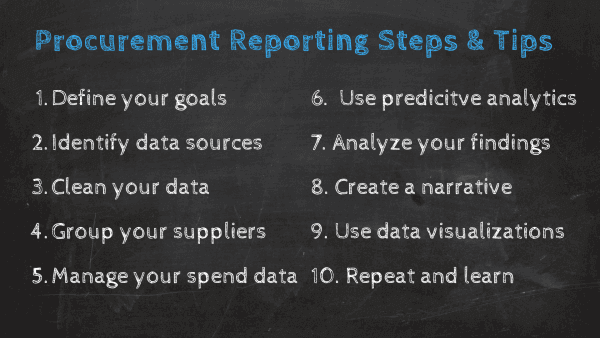
1. Define your goals and needs
The first step in your process should be to define your general goals and needs. This will help you organize your resources smartly and ensure consistency. Some common procurement analytics goals include lowering costs, increasing quality, and ensuring good relationships with providers, among others. However, reporting can also allow you to understand what role the department is playing in achieving general company goals. For this, you can ask yourself: What is procurement’s current strategic role in the organization? How collaborative are we with internal stakeholders that serve as customers? Is the procuring department responsible for the bulk of direct and indirect spending for the organization?
By answering these key questions, you can find improvement opportunities that will serve as goals for your department. But, to find all of this useful information, you first need to take care of your data, which leads us to our second point!
2. Integrate all your procurement processes
The procurement cycle involves many processes that need to go through various approvals and systems to get done. This can often create bottlenecks as stakeholders might need to access information for multiple locations. A professional reporting system eliminates this issue by allowing you to integrate all your processes and information into a centralized location. Through a professional and interactive business dashboard, companies can integrate and automate these processes to cut the manual work and ensure everyone can swiftly access and share the necessary information.
3. Identify and gather all your data sources
No matter how big or small your company is, you must gather and consolidate all your sources – from all the departments and units, including accounts payable, E-Systems or various formats, flat files, databases, etc. Pulling information from many sources will create more confusion than sustainable growth. You must include a common interface where your data will be stored and ready to extract or manipulate whenever a manager or team member needs to create a report. Maybe it sounds like this process would take a while, but using a dashboard builder will ensure your information becomes visualized with just a few clicks without spending countless hours or days in the process.
4. Clean your data
After you have identified and gathered all your data, you need to clean, categorize, and organize it. Professional tools can help you in this step so you don’t have to manually calculate or search through endless files for the right information. Remember to standardize your analysis based on the information you’re looking for. You also need to harmonize all your transactions to be able to increase visibility on all your spending processes and ensure that your procuring strategies will increase productivity. This might sound scary and daunting, but luckily, we live in a digital arena where you can utilize modern machine-learning features and let the software do the hard work.
5. Use real-time insights
Having access to real-time information as soon as it is generated is one of the greatest benefits of modern analytics. Introducing a mix of real-time and historical insights into your procurement reports can present a significant competitive advantage for your organization. Through it, the CPO can quickly extract information about suppliers and buyers, prices, inventory, and invoices and gain a 360-view of performance to build powerful strategies and make critical decisions based on accurate facts instead of intuition.
6. Group your suppliers
To ensure maximum success, it is crucial to group and connect your suppliers so that they have a clear link with each other. For example, if one of them is Coca-Cola Co., make sure you group all its companies together, such as Sprite, Fanta, or Coca-Cola Zero, as they belong to the same provider. That way, you will minimize any potential errors during your purchasing processes and obtain the correct information for the management of your suppliers.
7. Manage your spending data
You need to analyze and optimize your spending data from internal and external sources to be able to drive your company forward, decrease costs, and improve the relationship with your suppliers, for example. This is one of the key parts of your procurement analysis since you can easily identify opportunities and improve the visibility of your spending processes. In this step, you can utilize the 5Ws: Who? What? Where? When? Why? By adding the how, you can assess your expenditures and see where to allocate your resources better. Some of the questions may include:
- Who are we buying from?
- What are we buying?
- When (how often) do we buy?
- Where are the products being delivered?
- How can we compare the data with previous periods?
If you add spend forecasting that will ensure you have a clear understanding of the potential impact on profits of the procurement processes, you can obtain a birds-eye view of your whole lifecycle and decrease your costs. More on forecasting on the next point!
8. Use predictive analytics and automation
Expanding on the point above, forecasting and automation can be two invaluable tools for building efficient procurement reports. On one hand, predictive analytics techniques allow you to analyze historical and current data about spending, catalogs, providers, materials, and more to find trends and patterns and predict future outcomes. Armed with accurate forecasts, organizations can optimize their strategies, predict future price trends and possible risks, and find innovation opportunities.
On the other hand, paired with predictive analytics, you can benefit from automation technologies. Generating reports periodically can take hours or even days. BI reporting tools such as datapine offer automation technologies that allow you to automatically generate a report with the latest data available. This way, you can maximize your efforts by staying one step ahead of any new developments.
9. Make your reports interactive
The static nature of traditional analytics tools, such as Excel, are no longer enough to keep up with the fast-paced nature of the current business world. Today, decision-makers need to be able to extract insights from their reports in an interactive and agile way. That is why it is a great practice to invest in a reporting tool that offers interactivity options. For example, being able to drill down into lower levels of data, change the periods being analyzed, or even filter an entire report to see an individual supplier. These options allow users to explore their KPIs in a centralized location, enabling them to answer any questions that arise.
10. Analyze your findings
Whether you need to monitor and analyze specific supply chain metrics or ensure that you have negotiated the best possible contract deals, you must regularly analyze your processes. That way, you can reduce the number of providers per category and negotiate better contract rates, which will, in turn, reduce your costs significantly. Remember that cost savings can only be accomplished if your calculations and previous steps, such as cleaning your data, are done correctly. That way, you can develop purchasing reports for management or send them to your colleague in a matter of minutes. Of course, we suggest using modern technology since time is money, and you need software to collect, store, analyze, and monitor your data based on powerful BI features such as machine learning and smart data alerts.
11. Create a narrative
The procurement journey is much like a story—it has a definitive beginning, middle, and end. That said, once you’ve analyzed your findings, you should use your KPIs and visualizations to create a narrative or tell a data-driven tale.
The reason data-driven storytelling is so effective is that human brains respond best to narratives. By creating a logical plot with your KPIs, you can use your sourcing reports to make your information accessible across the board, improving internal communication while ironing out inefficiencies within the supply chain. Also, when you paint a picture that is digestible and easy to understand, you’ll likely get executive buy-in for new strategies and investments.
To help you get started, you can check our article on the subject: data storytelling examples.
12. Rely on data visualizations
Analyzing big sets of data and getting every relevant stakeholder involved in the process is not an easy task, and the procurement department is not an exception. We just discussed the importance of creating a narrative, but how do you make that narrative understandable, intuitive, and interesting for your audience? The answer is simple: data visualizations.
As we’ve mentioned at some point throughout this article, traditional means of reporting are static, and creating them is very time-consuming, not to mention that they are complicated to understand for users with no technical knowledge. With this issue in mind, various technologies have emerged to make the process a more intuitive task. BI dashboard software such as datapine offers a set of graphs, charts, and dashboards to visualize your most relevant procurement data with just a few clicks.
Using a set of interactive visualizations to tell your story will help you make your insights more understandable while enhancing communication between relevant users. An important note here is that not all types of visualizations will be useful for every purpose. It is critical to follow some data visualization techniques that will help you tell your data story in the most efficient way possible.
13. Last but not least, repeat & learn
We can conclude this section with a simple notion: repeat. Whether you need to upscale your financial reporting procedures to create a more efficient procurement strategy or clean your data to know whether a supplier is worth your efforts, you must continuously evaluate your strategies.
As mentioned, modern technology can help you in the process and update your information automatically and send it to stakeholders, colleagues, or management by setting automated schedules, and you won’t need to use spreadsheets or manual calculations ever again. A business intelligence dashboard can simplify your processes and help you create the best possible procurement management report daily or just alarm you if an anomaly occurs.
"A point of view can be a dangerous luxury when substituted for insight and understanding." - Marshall McLuhan, Canadian Communications Professor
Common Challenges & Mistakes Of Procurement Reporting & Analytics
Even though data-driven decision-making is a solid part of today’s modern business landscape, the analytics and reporting process still comes with various challenges that can lead organizations to make avoidable mistakes. This is no different in procurement, where the department needs to efficiently manage the data they generate daily to extract the maximum potential out of it.
Understanding what these challenges and common mistakes entail can allow the CPO to effectively manage all procurement-related resources efficiently. As you’ve learned earlier in the post, this department manages people, technology, and several processes throughout its daily operations. These three areas need to be connected and efficiently managed to ensure the large amounts of information gathered can be used well and no monetary or time resources are lost.
To mitigate the potential consequences of these challenges and mistakes, below, we will discuss the most common ones and provide some insight into how to tackle them effectively.
- Security and privacy
As mentioned throughout the post, modern procurement strategies rely heavily on automation to reduce their buying cycle time, mitigate the risk of errors, and ensure data insights are generated and managed in an efficient and agile way. That said, with the power of automation and a digital environment also comes security and privacy challenges. These challenges become increasingly complex as the company’s supply chain grows and more sensitive information about internal processes, suppliers, and clients is generated.
This sensitive information, which includes credit card numbers, bank account details, social security numbers, and confidential contract agreements, among many others, is highly interesting for cyber criminals that can use it to perform financial crimes, identity thefts, or even sell it to competitors to provide them with an advantage. But not just that, these kinds of attacks can also heavily affect the organization from a reputational and financial perspective.
To avoid falling victim to one of these attacks, you need to ensure your reports and the insights contained in them are fully protected at all times. This involves training employees on the importance of protection but, most importantly, investing in a tool that offers the highest levels of security available. For example, datapine’s procurement analytics software offers users high-level security measures that include encryption, user-role management to access reports, and password-protected URLs to share them.
- Data quality
Data quality is just as important as security. The consequences of using poor quality data in procurement can lead to incorrect decisions and a waste of resources on wrongly implemented strategies—for example, an excess or shortage of inventory that translates into higher inventory carrying costs.
Taking all that into account, it is essential to ensure you are working with the highest quality information. This can be achieved by implementing quality controls from when the data is generated to how it is accessed and manipulated. Doing so will ensure you are extracting the maximum potential out of it, putting the department in the best position to negotiate the right prices and build profitable supplier relationships.
- Lack of transparency between departments
In the past, organizations relied heavily on spreadsheets to gather and access their data. The issue with these tools is not only their static nature but also that they become more complicated to use as the information being gathered becomes larger and harder to access and track. Not to mention the security concerns of sharing a document like that with multiple people. In time, using spreadsheets can lead to mistakes for using the data incorrectly but also to a lack of transparency as accessing information becomes harder and harder for other departments, such as finances. In fact, research has shown that 60% of procurement leaders believe that a lack of transparency between relevant players represents a big risk.
To boost transparency and tackle this challenge, you should ditch the spreadsheets and move on to a modern and automated reporting approach that allows all relevant stakeholders to easily access reports. A procurement dashboard creator will allow you to automatically connect all your most relevant sources of information and visualize them without any errors in an interactive and centralized location. This way, you’ll ensure your data has the highest quality and can be shared and accessed easily and securely to support any discussions that arise.
- Leveraging tools in the correct way
Expanding on the point above, moving from traditional management reporting tools, such as spreadsheets, to innovative business intelligence tools that automate your analytical processes from collection to report-sharing can also present a challenge. Procurement activities are complex, and employees need to understand the value that these technologies can provide to their daily operations to make the most out of them. Most BI tools in the market offer a self-service approach that enables anyone, without the need for technical knowledge, to generate reports in just a few clicks. This will allow employees who already felt comfortable generating POCs or onboarding suppliers manually to integrate automation and alleviate their workload as well as significantly reduce the risk of errors that can impact the decision-making process.
To be able to see how all of this is done in action, we have prepared a list of procurement reports samples that you can take a closer look at and implement in your own strategies.
Top Procurement Report Samples & Templates
Now that we’ve looked at how to create this kind of report explored the benefits, and studied a range of essential tips, we will look at the five primary dashboards demonstrating their boosting power in action.
1. Procurement KPIs Dashboard
Whether you deal with physical goods or digital services, procurement is equally important. This is because this department links the needs of an organization with its contractors and, as such, plays an integral role in the competitiveness of any business.
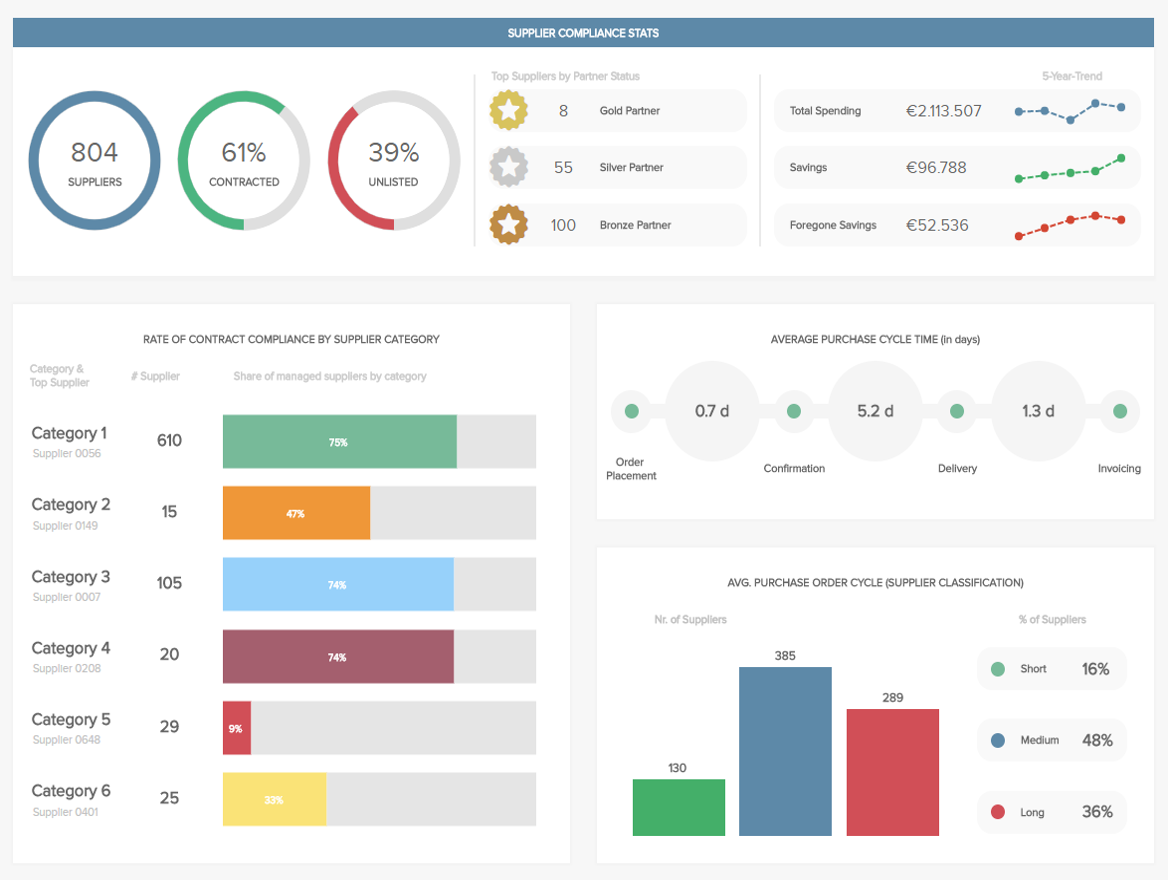
**click to enlarge**
That said, this procurement status report template offers a comprehensive overview of the various metrics that are vital to the success of the department. This intuitive and interactive dashboard helps in summarizing the department’s main activities as well as its relationship with the company’s suppliers. In turn, the dashboard not only helps with the smooth and successful management of the department but also assists in building brand awareness.
This dashboard will enable you to pinpoint and track metrics found in most procurement departments, alongside details and the possibility to drill down, interact, and filter each part of the visualization. Moreover, you can easily export or set up automated reporting for each week or month, for example, to have this dashboard delivered to your inbox with fresh and updated data. With the help of online business intelligence software, procurement has never been easier to manage.
Main KPIs:
- Compliance rate: In procurement, compliance represents the basic agreements set by a company and its supplier. By breaking down each supplier into definitive categories, this particular KPI provides a clear-cut snapshot of how compliant your various partners are and if any changes should be necessary.
- The number of suppliers: This KPI tracks the level of dependency you have on your suppliers over a particular time frame. Relying on too few suppliers and failing to diversify your sources can cultivate a significant risk of dependency. On the contrary, too many can reduce the possibility of valuable discounts. This priceless metric will help you decide on the optimum number of providers for your organization.
- Purchase order cycle time: This is a metric that measures the end-to-end ordering process, from the moment a purchase order is raised to the order approval, receipt, invoice, and payment. By reducing this time and ironing out any inefficiency, you will not only improve your productivity rate but also help to enhance your brand’s reputation.
2. Supplier Delivery Dashboard
This procurement reporting dashboard is based on a supplier’s ability to provide your business with the right products and services at the right time.
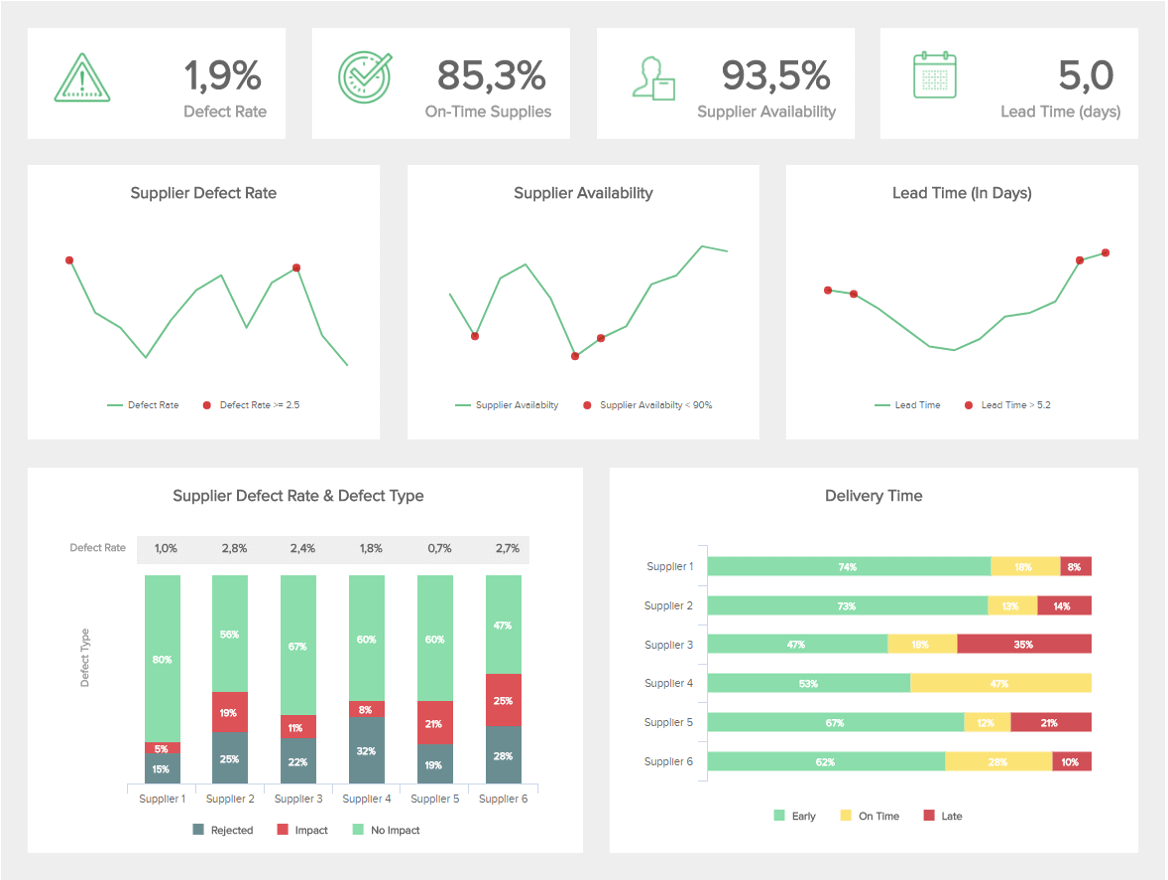
**click to enlarge**
With a mix of metrics and KPIs based on elements such as defect rates and delivery times, all geared towards offering valuable information on the performance of single suppliers as well as overall, this is one dashboard that your business definitely needs. Distributors are one of the crucial parts of the procurement strategy, and you have to measure each part of your relationship and contract, such as the defect rate, suppliers’ availability, load time, etc. Let’s take a closer look at these invaluable KPIs.
Main KPIs:
- Availability: This KPI measures your suppliers’ capacity and ability to respond to urgent demand consistently. In an age where consumer purchasing habits are constantly changing in response to the growing number of buying channels, it’s never been more critical to ensure that your distributors are available to cope with fluctuating volumes of orders and requests. And this KPI will help you do just that.
- Defect rate: In our fast-paced digital age, there’s little time for error, and consistent defects can prove to be detrimental to the reputation of a brand. This invaluable KPI measures the quality of your individual suppliers concerning quality and service and product and helps you nip potential issues in the bud before they prove harmful to yourself, your partners, and your customers.
- Lead time: The lead time assists in quantifying the total time it takes to fulfill an order. The concept of this insight is to reduce the lead time as much as possible while maintaining an exceptional level of quality.
3. Procurement Costs Dashboard
The third of our procurement report examples drills down to the costs and purchases associated with your various activities.
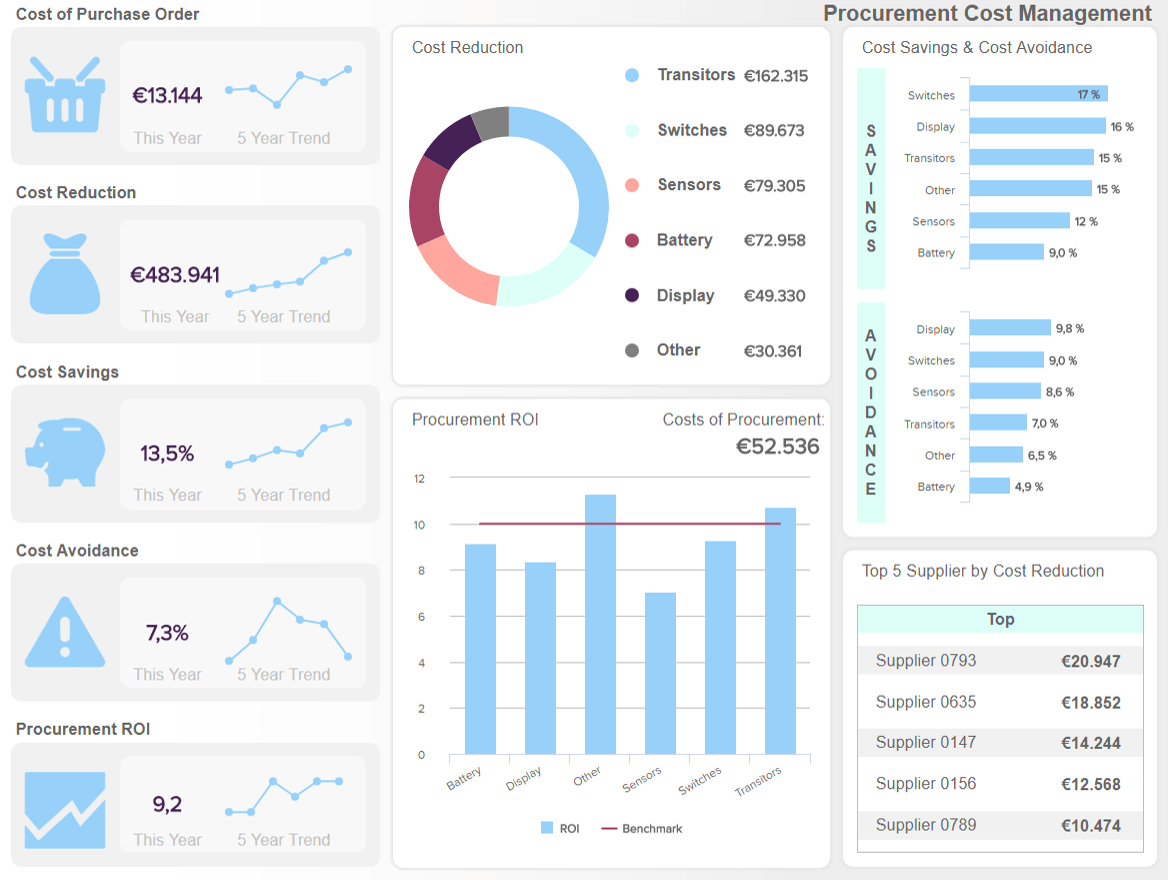
**click to enlarge**
To successfully optimize these costs, anticipate the needs of the various business units across the organization, and ultimately save valuable time, it’s vital to oversee the entire purchasing area in one central place. This example offers a panoramic snapshot of all valuable cost-based information. As mentioned, one of the main goals of a successful procuring process is the ability to effectively manage costs. If you obtain a high-quality level of your cost management processes by tracking KPIs such as cost reduction, avoidance, and ROI, you can reap endless rewards. Let’s see these main KPIs in more detail.
Main KPIs:
- Cost of purchase order: This metric helps to monitor and control the internal costs incurred by every purchase the business makes, thereby theoretically representing the average cost of processing an order, from purchase creation to invoice closure. These costs come with an incredible level of variation, so it’s important to look at them carefully and decide on the average cost of a purchase order based on the length of time it takes.
- Cost reduction: One of the most central components of the Procurement cost report, this KPI helps to streamline tangible monetary savings across all activities and processes, boosting an organization’s economic efficiency in a significant way.
- Cost avoidance: By offering a view of your various contractors and their activities in association with your business, you’ll be able to understand the areas of inefficiency that are incurring the business unnecessary costs and develop a strategy to avoid them in the future. These are called ‘soft savings’ because they don’t go directly to the bottom line. Despite this, these savings are nonetheless invaluable.
- Procurement ROI: The ROI helps to determine the profitability of investments made within your procurement department. To calculate your ROI, you must divide the annual cost savings by the internal yearly cost of procurement and express it as a ratio. Doing so will help you gain maximum value from your investments, and by measuring these metrics along with other key indicators, you will see significant improvements in a relatively short time.
4. Procurement Quality Dashboard

**click to enlarge**
Next is our quality dashboard. An effective procurement report example, this most dynamic of dashboards drills down into the end-to-end quality of the supply chain.
For a procurement process to remain robust and resilient, maintaining quality is essential. By analyzing specific metrics, it's possible to streamline your relationships with suppliers while creating better contracts and maximizing your business value in the process. Armed with a cohesive mix of quality as well as budgetary-based metrics, this cutting-edge, cost-saving template will help you drill down into specific pockets of your strategy, ensuring key elements of your supply chain are working at optimal efficiency.
With a logical and visually digestible design, this robust purchasing report sample offers swift access to key metrics centered around top suppliers, supplier cost and rejection rates trends, spending under management, and more.
Every KPI and metric included within this dashboard will tell you all you need to know to optimize the quality of your procurement processes – and we will explore them in more detail now.
Main KPIs:
- Quality rating: A KPI based on monitoring and benchmarking the performance of your supplier relationships, both present and future. The quality rating will help you troubleshoot issues in your supply chain head-on while evaluating the value of your contractor's relationships with pinpoint accuracy. If you notice lags or specific issues, you can take corrective measures while making necessary supplier changes.
- Vendor rejection rate & costs: This purchasing department monthly report will help you analyze your quality management strategies with diligence and confidence. Your vendor costs and rejection rates are pivotal to the ongoing growth of your business. By monitoring this metric regularly, it’s possible to nip costly issues in the bud while formulating strategic initiatives that will ensure the ongoing health of your procurement processes.
- Emergency purchase ratio: This purchasing report template metric will give you the tools to track your emergency purchases over a particular time frame. By doing so, you can tackle potential financial discrepancies and organizational bottlenecks that will stunt the growth of your business. The aim is to keep your ratios low to drive sustainable growth across the business.
- Purchases in time & budget: This metric will empower you to drill down into specific costs according to the procurement category. Here, you will gain an accurate snapshot of where your budget and spending will drive your initiatives. By tracking these metrics stringently, you can take valuable measures that will keep you on time and budget long-term.
- Spend under management: This KPI is incredibly valuable for tracking and optimizing your top-level expenditures. It’s presented in a logical line-style chart, and you can remain on track regarding your budget while spotting trends based on key fiscal elements of the procurement process, such as underutilized savings. This is a powerful metric for improving and maintaining financial health consistently.
5. Procurement Purchasing Dashboard
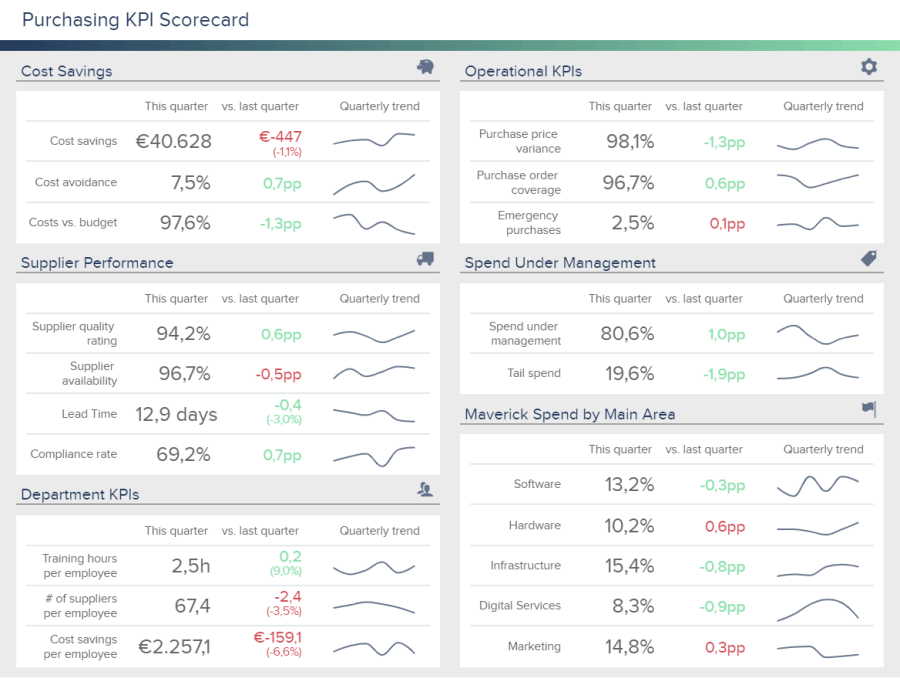
**click to enlarge**
Last but not least, we have a KPI scorecard tracking the long-term performance of five critical areas: cost savings, supplier performance, department KPIs, operational KPIs, spend under management, and maverick spend by main area. The scorecard format of this valuable procurement report template makes it the perfect tool to track progress against a set target or benchmark. In this case, the performance of the previous quarter. Allowing you to easily spot trends and improvement opportunities in the different areas.
The 360-degree view provided by this template allows the CPO to gain a complete picture of how everything is developing and where improvements could be made. With this information in hand, procurement can ensure that spending is under control, that supplier contracts are running as expected, and that the department is making the most out of the resources available to them.
Let's explore some of the most important KPIs covered in this valuable procurement report format!
- Purchase price variance: It tracks the difference between the price the company paid for a product or service and the price they expected to pay during planning and budgeting. A positive purchase price variance means the department was successful at negotiating deals with vendors.
- Purchase order coverage: This metric tracks the percentage of invoices that can be matched to a purchase order. Naturally, you want this to be as high as possible, as a lower rate can mean the procurement team is not successful at processing orders, which can bring financial consequences and damage supplier relationships.
- Maverick spend: This KPI tracks the spending of goods or services from non-contracted or non-preferred providers. This can happen because of a lack of communication between a certain department and the procurement team, and it can increase costs as you most likely have discounts and other beneficial terms with your preferred suppliers. Therefore, it should be kept at a minimum.
Types Of Procurement Reports
Now that we’ve covered a few visual examples, we will go through some common types of procurement reports that are used within organizations.
- Spend: As its name suggests, the spending report helps to monitor budgeting and the overall financial performance of the procurement department. They can be used to compare actual spending to approved budgets in real time and spot any inefficiencies before they become bigger. Some of the common questions answered with spend analysis include: What are we buying? Who are we buying it from? How often do we buy? When did we buy it? among others. Through this, businesses can decrease costs and increase efficiency.
- Supplier base: It helps to track every relevant detail related to individual supplier development. It usually contains detailed information that allows users to assess risks, sustainability, costs, and inventory usage, as well as compare the developments of different suppliers and extract relevant conclusions that can lead the company forward.
- Accounts payable: The Accounts payable (AP) allows you to streamline your supply chain by finding ways to cut costs and still maintain quality across the board. If the procurement process is generating more spending than it is supposed to, it can lead to inefficiencies and a waste of time and resources. To avoid all of this from happening, AP allows for the optimization of cash flow management, minimizing risks, and finding innovation opportunities that will set the business apart from its competitors.
- Category analysis: This type uses category management techniques to group data from materials, goods, and services into categories for opportunity identification. This allows for the identification of supplier trends over time and improvement opportunities in category performance.
- Contract management: As its name suggests, this type of procurement report sample covers different aspects of contract management. It provides guidance and pertinent information regarding contracts, compliance, and opportunities for potential partnerships with suppliers that can benefit the company. It also covers aspects such as payment terms and expiration dates to ensure every contract is running smoothly.
- Savings lifecycle analysis: In simple words, the savings lifecycle is used to evaluate the effectiveness of cost-saving actions over time. Companies use it to assess the impact that the different saving initiatives have on the financial bottom line of the procurement process.
Start Creating Your Reports!
It doesn’t matter what niche or industry you specialize in – without utilizing data to make better decisions, uncover essential insights, and develop narratives that create a real organizational impact, you will fall behind your competitors. Procurement is a delicate and vital aspect of almost every modern business. In the Age of Information, there are no excuses for shooting in the dark.
When it comes to procurement, there is little margin for error. By sweating your data the right way, you will not only keep your initiatives on track but also respond to sudden changes and formulate strategies that will ultimately accelerate the success of the business as a whole.
In summary, procurement analysis is essential to the success and evolution of your business. By using this range of innovative insights to your advantage, you will earn the level of commercial success that will push you ahead of the pack. With the assistance of a cutting-edge procurement dashboard, you will harness your data in ways you never thought possible.
To find out more about enhancing your procurement analytics efforts with the power of dashboards, you can connect with us or try our 14-day free trial. We look forward to hearing from you!